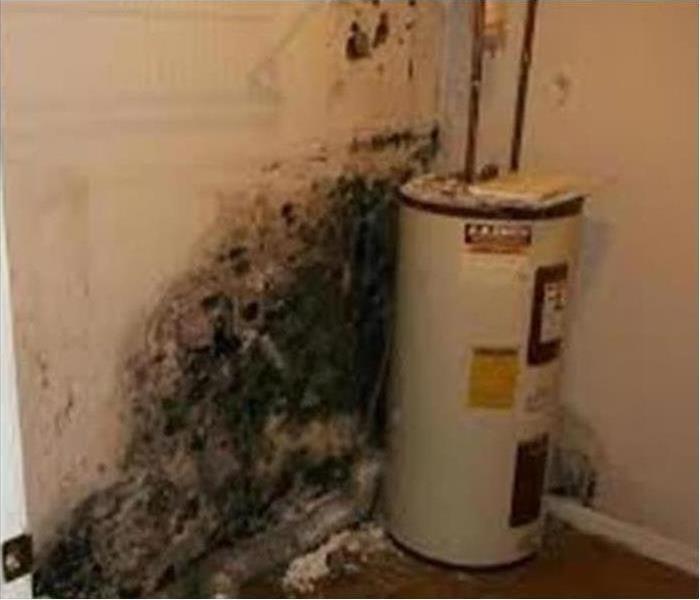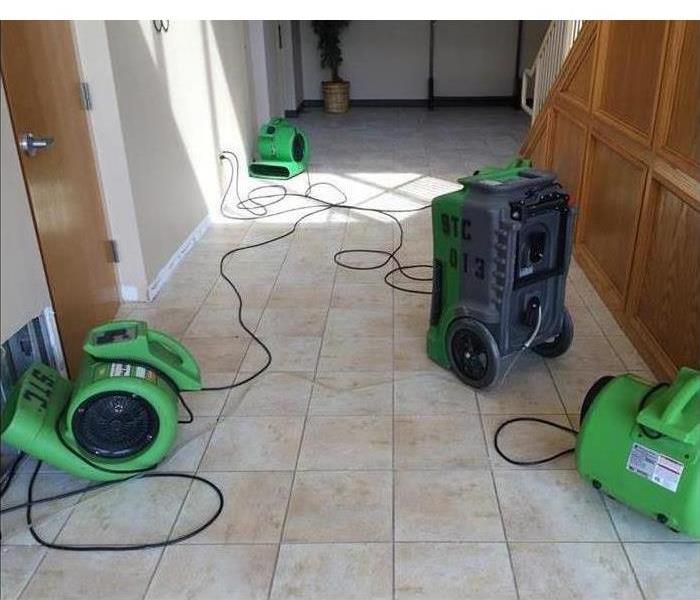Archived Why SERVPRO Blog Posts
Mold FAQs
7/28/2022 (Permalink)
 Mold from water heater break
Mold from water heater break
What To Do If Your Home Is Suffering From Mold Damage?
Mold growth is an extremely common issue that the vast majority of homeowners do have to deal with at some point. Ensuring that you take care of the problem quickly and effectively is the best way to prevent a tiny mold problem from spiraling out of control. Read on to have some of your common questions answered, especially if you suspect that your Somers Point, NJ, home is suffering from a mold issue.
1. Where is Mold Commonly Found?
Mold thrives in damp, dark places. This means that rooms, such as your kitchen, bathroom, garage and basement are all especially susceptible to unwanted mold. Any areas in your home that have recently suffered some type of water damage are also at risk.
2. How Can You Tell Whether You Have a Mold Problem?
You can usually spot mold with the naked eye. Black mold, one of the most common residential varieties, looks like a dark black or green stain that spreads across the surface of an object. A musty or dank smell is also a good indication of a mold presence.
3. How Can You Prevent Mold Growth?
Keeping your home as clean and dry as possible is the best way to prevent a mold issue. This involves cleaning spills and leaks as soon as they occur, ensuring your home doesn't suffer from high humidity levels and properly ventilating your home to prevent condensation from building up. Performing regular mold inspections can also help you catch the issues while they're still small.
4. Does Mold Go Away By Itself?
Mold is a living organism, so it's natural to assume that you'd be able to get rid of it simply by depriving it of its vital nutrients. Unfortunately, this isn't the case. Cutting off the mold's access to water and organic matter could potentially halt its spread, but it won't kill the existing mold.
It's important that you address a mold issue swiftly and effectively in order to prevent the situation from becoming worse. If you discover unwanted mold growth in your home, make sure to contact mold remediation experts immediately.
Tips for Preventing Bathroom Mold
7/19/2022 (Permalink)
Ways To Limit Mold Buildup in Your Bathroom
Water damage to your Margate, NJ, home is more than just a minor inconvenience. It can also encourage the growth of mold throughout your house. Mold thrives in moist areas, so any wet locations are more susceptible to the fungus.
It is thus no surprise that bathrooms are a common location for mold. However, there are steps you can take to limit the buildup of mold near your sink or bathtub. All you need is:
- A squeegee
- A scrub brush
- Grout sealer
Bathroom Walls
Whenever you use your shower, its walls quickly get coated in water. If you let this water sit there, mold will start to develop. You should thus squeegee the walls each time you take a shower or bath.
Grout
While tile adds a bit of style to your bathroom, it is also prone to water damage. In particular, water can get trapped in the grout lines between each tile. You should thus apply grout sealer to the tile annually. Use a toothbrush for those hard-to-reach locations.
Fans
Bathroom fans are another great mold prevention tool. Run your fan every time you use the shower or bath, and keep on the fan for at least a half-hour afterward.
For best results, choose a fan that removes most of the moisture within five or 10 minutes. If your fan takes longer than that, then you should switch to a fan that has a larger airflow. Calculate your bathroom's ideal airflow by multiplying its square footage by 1.1 (if you have an 8-foot ceiling) or 1.5 (if you have a 9-foot ceiling).
To prevent mold, you need to limit the amount of moisture in your bathroom. Still, even if you do keep your bathroom fairly dry, a sudden leak or pipe emergency can cause severe water damage that leads to mold growth.
Trying to clean this mold on your own only exacerbates the problem. However, local mold remediation specialists can address the fungus promptly.
How Pretesting After a Home Disaster Can Reduce Insurance Claims
2/17/2022 (Permalink)
A disaster such as a flood at your Ventnor, NJ, home can be devastating. Not only could it displace you and your family, but it can also severely damage or even completely ruin belongings, keepsakes, and even structural components of your house. You’re grateful to have insurance to help cover your losses. However, heavy claims can raise your premiums. To keep claims down, professional restoration teams can conduct extensive pretesting to determine what you can salvage and restore and what you must replace.
What is Pretesting?
This process works in tandem with the initial inspection, and it’s critical before you make an insurance claim. Your insurance provider expects you to make contact quickly after an incident so it knows what it can and will cover. Pretesting helps to accurately make claims by identifying the scope of the issues.
- Crews will determine what materials and portions of your home were affected.
- Crews will determine if any parts of your house were untouched by damage.
- Crews will determine what they can restore and what they must replace.
The Danger of not Pretesting
What would happen if you were to hire the wrong cleanup company—one that didn’t pretest and examine the scene following a flood or other disaster? In this case, you might report unnecessary losses to your insurance agent, which would result in higher claims and more long-term financial burden. A knowledgeable disaster restoration company carefully evaluates this entire scenario and helps limit the number of claims you have to make.
Sometimes Replacement Is Inevitable
There are cases when the company will discover during pretesting that the damage was too great to salvage a portion of your home or a belonging inside. It may be more cost-effective in some instances to replace rather than restore. The team will also determine how long both the restoration and replacement process will take.
Working with an insurance company can be a smooth experience. If you want to minimize claims, it’s best to work with a disaster response company that believes in pretesting.
Black Mold Is Like the Annoying Visitor Who Never Leaves
1/19/2022 (Permalink)
Black Mold Is Like An Inconvenient Friend Who Never Goes Away
The term black mold strikes fear into the hearts of homeowners everywhere. Few know anything about it. Here are some facts that you should know about this fungus:
- Stachybotrys is its technical name
- Stachybotrys is not always black
- Not all black-colored molds are Stachybotrys
- You don’t want it in your home
Perhaps you already have mold. You didn’t intentionally invite it to visit. You didn’t ask it to stay. It won’t leave anytime soon. It’s a nuisance. It’s unattractive. It’s destructive. It’s a threat. It won’t die. It needs to go. It’s not leaving voluntarily.
Mold Is Relentless
If you go on vacation and your houseplants don’t get watered, they are dead when you return home. No amount of water is going to revive them.
If you remove the source of moisture from black mold, it becomes dormant. When the moisture returns, it comes back to life as if nothing happened.
Start by Finding All the Mold
You found the mold in your home and called in experts to help with the remediation. However, it is important to locate all the mold colonies before the cleanup begins. A conventional technique for finding them involves taking air samples throughout the home. Samples with the highest concentration of mold identify locations close to active colonies.
Mold Cleanup Requires More Than Eliminating the Moisture Problem
The secret to getting rid of mold is to destroy it without releasing any into the air. There are many techniques for doing this. They all require the cleaner to wear a mask and other protective equipment. Some of these techniques are:
- Abrasive blasting with baking soda or dry ice
- Treating with chemicals that kill the mold
- Vacuuming with HEPA filters
Don’t allow the situation to get worse. Call on a team of mold remediation specialists in the Linwood, NJ, area to solve your black mold problem. They are only a phone call away.
What You Should Know About Category 1 Water Damage
12/15/2021 (Permalink)
 Water damage at an office building in Linwood, NJ.
Water damage at an office building in Linwood, NJ.
If your business in Linwood, NJ, is affected by water damage, starting the restoration process quickly can save you time and money. However, category 1 water damage, known as clean water, is often handled differently than other categories of water damage. Knowing what category of water damage your business has sustained can help you prepare for the cleanup process.
What Are the Causes of Category 1 Water Damage
Category 1 water damage is generally considered to be the least severe category of water damage. Common causes of category 1 water damage can include, but are not limited to:
- A damaged supply line
- A broken pipe
- Overflowing water from an appliance
What Do Categories of Water Damage Mean?
Water damage categories are referred to numerically, with the least severe category being 1 and the most severe category being 3. Specifically, categories are classified by the following:
• Category 1: known as clean water, the water is not contaminated and isn’t hazardous to be around
• Category 2: known as gray water, the water is somewhat contaminated and should be removed with caution
• Category 3: known as black water, this type of water damage is highly contaminated and can be hazardous to a person’s health
Can Water Damage Change Categories?
Although category 1 water damage is generally simpler to clean up, it is possible for water damage to change from one category to another. Though water damage is unlikely to become less severe, category 1 water damage can easily turn into category 2 water damage, just as category 2 water damage can turn into category 3 water damage. Even if the original source of the water was clean, sitting water can become contaminated over time, making mold growth likely.
Even though category 1 water damage is considered less severe than other categories of water damage, clean water can still be costly to a business. If your business has sustained water damage, consider contacting professionals who are experienced in water damage restoration.




 24/7 Emergency Service
24/7 Emergency Service

